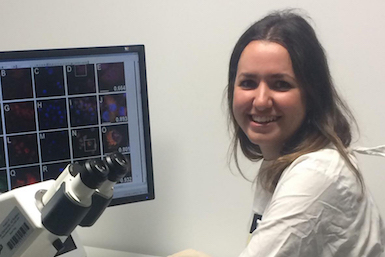In 2020 we invested in 11 of the brightest and best cancer researchers from across Australia.

Dr Angelica Merlot

Children's Cancer Institute
Investigating how the human body works in normal and disease conditions
Dr Merlot was awarded the Harvey Norman NSW Young Woman of the Year Award in 2019.
Her work aims to better understand the mechanisms by which pancreatic cancer cells grow and adapt to their environment, why current treatments become ineffective and the development of nanoparticles to improve drug delivery.
The Scientia Fellow at UNSW Medicine has dedicated her career to the deadliest of cancers, pancreatic cancer, knows as a 'silent killer' because it's so aggressive.

Dr Emmy Fleuren

Children's Cancer Institute
Identify novel therapeutic targets in sarcoma and develop more selective and effective therapies to combat sarcoma in children
Originally from the Netherlands, Dr Emmy Fleuren moved to Australia from the United Kingdom in 2019 to join Children’s Cancer Institute. Developing more selective and effective treatments to combat sarcoma in children. The senior scientist is dedicated to helping improve the cure rates for children with sarcoma using therapies that specifically target the tumour cells that are more effective and less likely to cause damaging side effects.
Find out more about Dr Fleuren’s research

Dr Kelly Brooks

QIMR Berghofer Medical Research Institute
Investigating poly-ADP ribose polymerase inhibitors (PARP) for the treatment of splicing factor 3b subunit 1 (SF3B1) mutant melanoma
PARP inhibitors are drugs that disrupt cancers cells ability to repair their DNA and are currently used to kill certain cancers. Eye melanomas are a very deadly form of melanoma lacking effective treatments. Some of these melanomas have defects in SF3B1 as do some breast, pancreatic and blood cancers. This project will confirm early evidence suggesting SF3B1 defects make cancer cells sensitive to PARP inhibitors. This would provide a rapid and safe treatment for these patients over a number of cancer types.

Dr Marlene Hao

Univeristy of Melbourne
A gut feeling about new therapies for glioma research: lessons from the enteric nervous system
Gliomas are the most aggressive form of brain cancer. Gliomas can come from glial cells, a type of support cell in the nervous system. Glial cells are found in the brain and also in the enteric nervous system, which is located in the gut. Although glial cells are present in the gut, gliomas are rarely found in the gut and are generally benign. In this study, we aim to identify factors that protect enteric glial cells from forming aggressive cancers in order to develop new treatments for brain cancer.

Dr Nathalie Bock

Queensland University of Technology
Bioengineered humanised models: A novel preclinical platform for bone metastatic cancer research
Dr Nathalie Bock is looking to understand how and why cancers such as advanced breast and prostate cancer mestastasise and thrive in bones, presenting, to date, with no cure. She and her fellow researchers at QUT currently want to propose new and better ways of assessing prostate cancer when it has spread to bones.

Dr Niantao Deng

Garvan Institute of Medical Research
Understanding breast cancer patients’ response to neoadjuvant chemotherapy at single-cell
Chemotherapy prior to surgery is used with the intention of rendering large tumours operable in locally advanced breast cancer and has become increasingly common. Treatment responses can then be assessed in realtime, and tissue samples can be collected throughout the course of treatment. In this study, we would like to understand the mechanisms of resistance by comparing samples of responders and non-responders before and after chemotherapy at the single-cell level.




